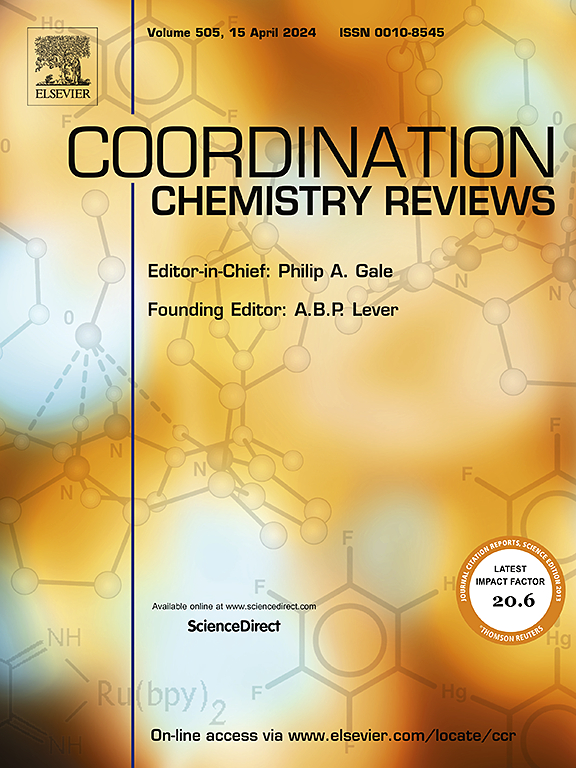工程高性能BiVO4同质和异质结光阳极,用于太阳能驱动的光电化学水分解应用
IF 23.5
1区 化学
Q1 CHEMISTRY, INORGANIC & NUCLEAR
引用次数: 0
摘要
经过半个多世纪对光电化学(PEC)水分解系统的深入研究,绿色氢作为最有前途的化石燃料替代品已经站稳了脚跟。与光电阴极相比,析氧反应所需的高过电位要求开发高性能的光阳极,因为它减少了水分解反应所需的外部偏压。钒酸铋(BiVO4)由于其良好的带隙、丰度和良好的化学稳定性而成为极具潜力的候选材料。然而,快速的载流子重组和缓慢的析氧反应严重影响了BiVO4的水裂解性能。为了充分释放其潜力,修饰是必要的,同质结和异质结的形成对增强PEC水氧化有重要贡献。本文综述了BiVO4的homo-结和异质结的构建策略,以及对提高太阳能水分解性能的启示。异质结的形成分为掺杂异质结、表面异质结和形态工程异质结,而异质结的形成则根据功能性质分为n-n、p-n和z -图式异质结。本文还深入讨论了基于异质结构BiVO4的无偏太阳能驱动的PEC水分解系统的发展,并对PEC水氧化的当前和未来研究进行了展望。本文综述了bivo4基光阳极的工程同质结和异质结的研究进展,为其他半导体在光电阳极上的应用提供参考。本文章由计算机程序翻译,如有差异,请以英文原文为准。


Engineering high-performance BiVO4 homo- and heterojunction Photoanodes for solar-driven Photoelectrochemical water splitting applications
Green hydrogen has secured its foothold as the most promising fossil fuel-alternative, with over half a century of intensive research focusing on the development of photoelectrochemical (PEC) water splitting system. The higher overpotential required for an oxygen evolution reaction necessitates the development of a highly performing photoanode as compared to photocathode, as it reduces the externally applied bias needed for a water splitting reaction. Bismuth vanadate (BiVO4) has emerged as an immensely potential candidate, due to its favorable bandgap, earth abundance and good chemical stability. However, the rapid charge carrier recombination and sluggish oxygen evolution reaction have severely undermined BiVO4's water splitting performance. To fully unleash its potential, modifications are necessary, with the formation of homo- and heterojunctions showing significant contributions in enhancing PEC water oxidation. This review comprehensively discusses and highlights the strategies for constructing homo- and heterojunction of BiVO4, as well as the insights in boosting the solar water splitting performance. The review on the formation of homojunction is classified into doping, facet and morphology-engineered homojunction, while the formation of heterojunction is classified based on the functional properties, n-n, p-n and Z-scheme heterojunction. The development of an unbiased solar-driven PEC water splitting system based on heterostructured BiVO4 is also thoroughly discussed, along with perspective on current and future research related to PEC water oxidation. This review aims to provide an extensive coverage of research on engineering homo- and heterojunctions for BiVO4-based photoanode, which will also serve as a reference for other semiconductors in enhancing their various PEC applications.
求助全文
通过发布文献求助,成功后即可免费获取论文全文。
去求助
来源期刊

Coordination Chemistry Reviews
化学-无机化学与核化学
CiteScore
34.30
自引率
5.30%
发文量
457
审稿时长
54 days
期刊介绍:
Coordination Chemistry Reviews offers rapid publication of review articles on current and significant topics in coordination chemistry, encompassing organometallic, supramolecular, theoretical, and bioinorganic chemistry. It also covers catalysis, materials chemistry, and metal-organic frameworks from a coordination chemistry perspective. Reviews summarize recent developments or discuss specific techniques, welcoming contributions from both established and emerging researchers.
The journal releases special issues on timely subjects, including those featuring contributions from specific regions or conferences. Occasional full-length book articles are also featured. Additionally, special volumes cover annual reviews of main group chemistry, transition metal group chemistry, and organometallic chemistry. These comprehensive reviews are vital resources for those engaged in coordination chemistry, further establishing Coordination Chemistry Reviews as a hub for insightful surveys in inorganic and physical inorganic chemistry.
 求助内容:
求助内容: 应助结果提醒方式:
应助结果提醒方式:


